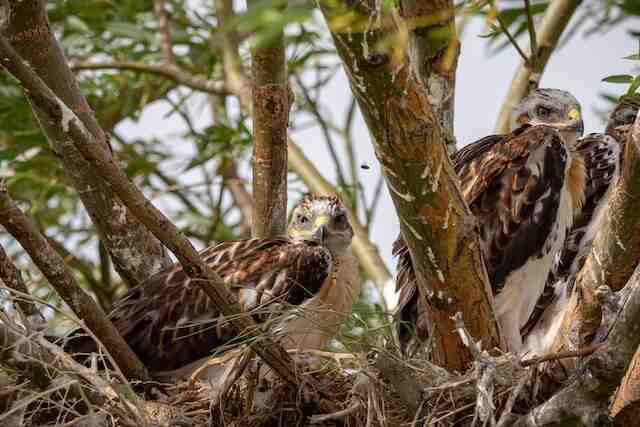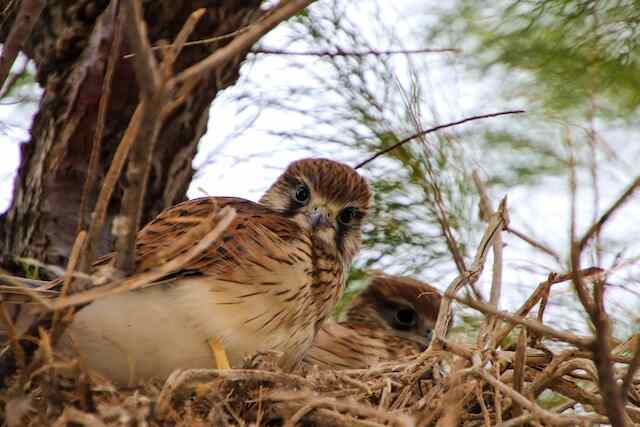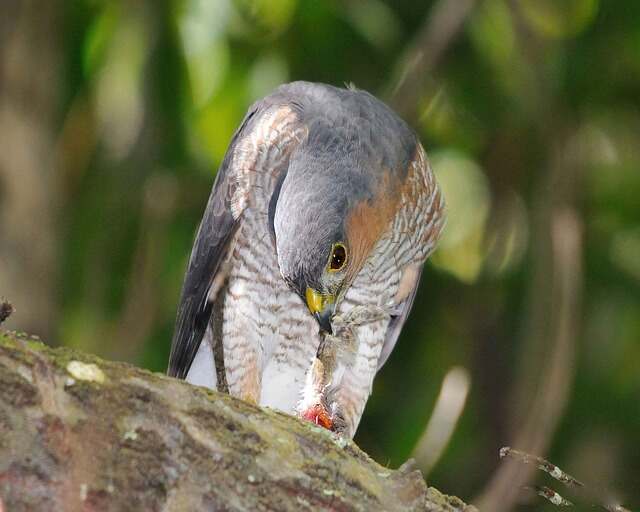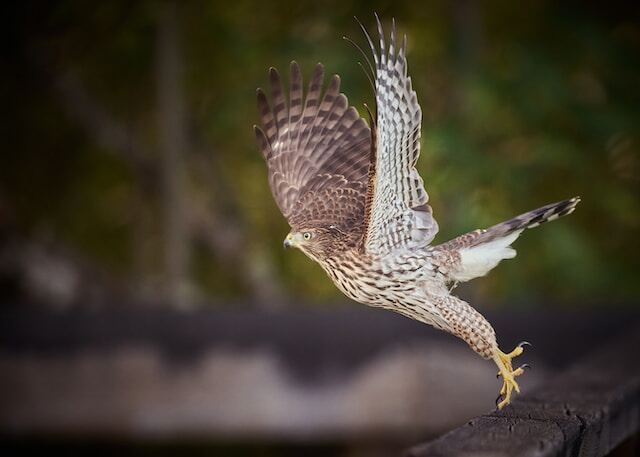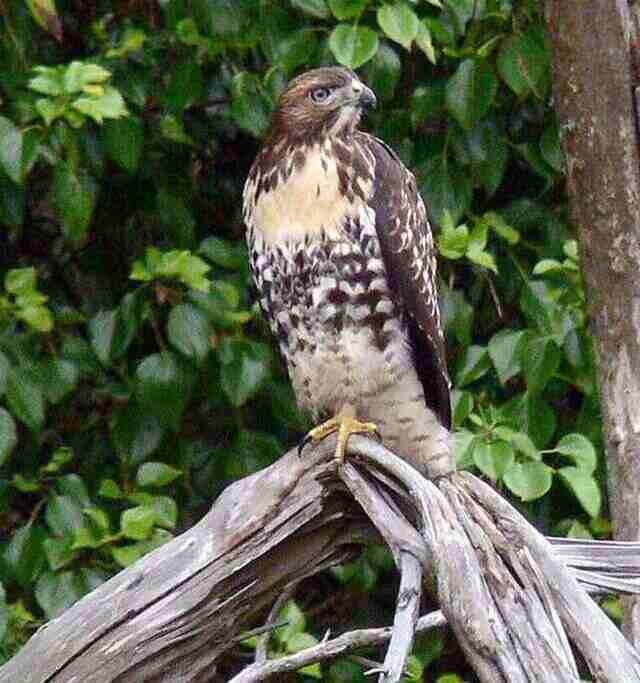Calling all nature detectives and treehouse aficionados! Brace yourselves for a winged wonder that’s about to take your arboreal adventures to soaring new heights. Today, we unravel the mysterious world of hawks and their tree-based real estate.
So, do hawks build nests in trees? The short answer: Absolutely!
But hold on tight, because we’re about to uncover the clever construction techniques, jaw-dropping aerial abodes, and the surprising stories behind these lofty hawk dwellings.
Prepare for an avian architectural extravaganza that’ll leave you pining for more feathered facts!
Table of Contents
- 1 Key Takeaways
- 2 Do Hawks Build Nests In Trees?
- 3 Overview of Hawk Nesting Habits
- 4 Types of Hawks
- 5 Characteristics of Tree-Nesting Hawks
- 6 Common Tree Species Used for Nesting
- 7 Nesting Behaviors During Breeding Season
- 8 Nesting Challenges and Threats
- 9 Non-Tree-Nesting Hawks
- 10 Impact of Nesting Habits on Conservation Efforts
- 11 Conclusion and Final Thoughts
- 12 Frequently Asked Questions
- 12.1 How do hawks choose the specific tree to build their nest in?
- 12.2 How long does it take for hawks to build their nest?
- 12.3 Do hawks return to the same nest every year?
- 12.4 How do hawks defend their nest from predators?
- 12.5 Can hawks build their nest on man-made structures, such as buildings or poles?
- 13 Author
Key Takeaways
- Hawks are known for their impressive flying abilities, keen eyesight, and powerful talons.
- They build nests in various habitats, including trees, cliffs, and man-made structures, and use twigs, sticks, and grasses to construct them.
- Different types of hawks have different nesting habits, with tree-nesting hawks preferring mature forests with tall trees, and have specific nesting location preferences.
- Protecting hawk nesting habitats and reducing human impacts is crucial for maintaining healthy ecosystems, preserving hawk populations, and controlling prey populations.
Do Hawks Build Nests In Trees?
Yes, hawks typically build nests in trees. They select sturdy branches and construct their nests using twigs, sticks, and other materials. These nests, known as eyries, are often built high off the ground to provide protection and a vantage point for hunting.
Overview of Hawk Nesting Habits
Hawk nesting habits, which vary depending on species, geographic location, and environmental conditions, are characterized by the construction of nests in a variety of locations, including trees, cliffs, and man-made structures.
Hawk nesting location preferences are influenced by a number of factors, including availability of nesting materials, proximity to food sources, and protection from predators.
Hawks typically construct their nests using a variety of materials, including twigs, sticks, and grasses, which are woven together to create a sturdy structure.
Nesting materials and construction techniques vary depending on the species of hawk and the location in which the nest is built.
For example, some hawks prefer to build their nests in trees, while others prefer to build them on cliffs or in man-made structures.
In addition, some hawks use a combination of materials to construct their nests, while others rely primarily on one type of material.
Transitioning into the subsequent section, it is important to note that different types of hawks have different nesting habits, which are influenced by a range of factors.
Types of Hawks
A diverse range of raptors belonging to the family Accipitridae, including species such as the Red-tailed Hawk and Cooper’s Hawk, display unique physical adaptations and hunting behaviors.
Hawks are known for their sharp talons, keen eyesight, and powerful wings that enable them to soar through the skies with agility and grace.
Different species of hawks have varying habitat preferences, with some preferring open grasslands and others preferring dense forests.
Some hawk species build their nests on the ground, while others build them on cliffs or in trees.
Tree-nesting hawks, such as the Red-shouldered Hawk and the Sharp-shinned Hawk, prefer mature forests with tall trees for nesting sites.
These hawks are known for their ability to build large, sturdy nests high up in the trees, providing a safe and secure home for their young.
Understanding the characteristics of tree-nesting hawks is important for conservation efforts and for maintaining healthy ecosystems.
Characteristics of Tree-Nesting Hawks
The preference for mature forests with tall trees as nesting sites is a crucial aspect of the habitat requirements for certain species of raptors belonging to the Accipitridae family.
Hawks are one such species, and they are known to build their nests in trees.
Tree-nesting hawks have specific nesting location preferences, which include mature forests with tall trees that provide adequate cover and protection from predators.
They also prefer to nest in trees that are close to a water source and have an abundant supply of small prey, such as rodents and insects.
When it comes to nesting material selection, hawks typically use sticks, twigs, and other plant materials to construct their nests.
These materials are carefully woven together to create a sturdy and secure structure that can withstand harsh weather conditions and provide a safe haven for their young.
Understanding the nesting location preferences and material selection of tree-nesting hawks is important for conservation efforts aimed at protecting their habitats.
In the subsequent section, we will explore the common tree species used for nesting by these magnificent birds of prey.
Common Tree Species Used for Nesting
Various tree species serve as ideal nesting sites for raptors belonging to the Accipitridae family. These species are selected based on their structural characteristics, such as size, shape, and stability.
Common tree species used for nesting include beech, maples, pines, oaks, and cedars, which provide a sturdy base for the hawk’s nest.
Additionally, hawks also select trees that are in close proximity to open fields, which provide a source of food for the birds during the breeding season.
Nesting materials, such as sticks and twigs, are gathered and arranged in a circular pattern to create the base of the nest.
As the breeding season progresses, the nest is reinforced with additional materials, such as leaves and grasses, to provide insulation for the eggs and chicks.
The selection of the tree and the arrangement of the materials are crucial for the success of the breeding season.
With this in mind, it is important to understand the nesting behaviors that hawks exhibit during this time.
Nesting Behaviors During Breeding Season
Pines, beech, maples, oaks, and cedars are selected as nesting sites for their structural characteristics, with over 80% of hawk nests being built in trees over 20 feet tall.
During breeding season, hawks exhibit specific nesting behaviors that are critical to their survival and the success of their offspring.
Hawks engage in elaborate mating rituals that involve aerial displays and calling to establish pair bonds, before selecting a nesting location.
Once a location is chosen, hawks will construct their nests using a variety of materials, including sticks, twigs, and grasses, to create a sturdy foundation.
They will also line the nest with soft materials such as moss, feathers, and fur to provide insulation for their eggs and chicks.
Despite these efforts, hawks face numerous challenges and threats during the nesting season, including predation, habitat destruction, and human disturbance.
These challenges can impact the survival of both adults and offspring, making it important for conservation efforts to focus on protecting nesting habitats and reducing human impacts on these vulnerable species.
Nesting Challenges and Threats
Predation, habitat destruction, and human disturbance pose significant challenges and threats to the survival of hawks during the nesting season.
Hawks typically build their nests in tall trees, but the increasing human interference in natural habitats has made it difficult for them to find suitable nesting sites.
This has led to the development of nesting platforms, which are artificial structures specifically designed to support hawk nests.
The use of nesting platforms has proven successful in providing hawks with secure nesting sites and has helped to mitigate the effects of habitat destruction.
However, these platforms also come with their own set of challenges, such as maintenance and monitoring.
Additionally, the increasing human presence and activity in natural habitats disrupts the natural nesting behaviors of hawks and can lead to abandonment of nests.
Therefore, it is important to be mindful of human interference when considering the conservation of hawks and their nesting habits.
Non-tree-nesting hawks have adapted to these challenges and have found alternative nesting sites, which will be discussed in the subsequent section.
Non-Tree-Nesting Hawks
Non-arboreal hawks have adapted to the challenges of habitat destruction and human interference by utilizing alternate nesting sites. Hawks in captivity, for example, often make use of artificial nest boxes provided by their caretakers.
Ground nesting hawks, on the other hand, make their nests on the ground, usually concealed in vegetation.
This nesting behavior, while uncommon among hawks, has proven effective for species such as the ferruginous hawk, which has suffered population declines due to habitat loss and human disturbance.
Ground nesting, however, comes with its own set of challenges, including vulnerability to predators and natural disturbances.
Nonetheless, non-tree-nesting hawks have shown resilience and adaptability in the face of changing environments.
Understanding the nesting preferences of different hawk species is crucial for conservation efforts aimed at protecting these magnificent birds and their habitats.
Impact of Nesting Habits on Conservation Efforts
Understanding the nesting habits of different hawk species is crucial for effective conservation efforts aimed at protecting these birds and their habitats.
The impact of nesting habits on conservation strategies cannot be overstated, as different hawks have varying preferences for nesting sites.
Some hawks, such as the Red-tailed Hawk, prefer to build their nests in trees, while others, like the American Kestrel, opt for non-tree nesting sites such as cliffs or buildings.
The choice of nesting site affects the success of breeding and survival of the hawks and, ultimately, their populations.
Human impact on nesting sites can have detrimental effects on hawk populations, which is why knowledge of nesting habits is essential for conservation efforts.
By understanding the nesting preferences of different hawk species, conservationists can create effective management plans that prioritize the protection of nesting sites and habitats.
Such strategies can help to promote healthy hawk populations and ensure their continued survival in the face of ongoing human activity.
In conclusion, the impact of nesting habits on hawk conservation cannot be overstated, and it is imperative that we continue to study and understand the nesting habits of different hawk species to develop effective conservation strategies.
Conclusion and Final Thoughts
Hawks are fascinating birds of prey that have captured the attention of people for centuries. Their nesting habits are of particular interest to bird enthusiasts and conservationists.
Hawks build nests in a variety of locations, including trees, cliffs, and man-made structures.
However, tree-nesting is a popular choice for many hawk species, and they display unique characteristics and behaviors during the breeding season.
There are several types of hawks, including buteos, accipiters, and falcons. Each species has its unique nesting habits and preferences.
Tree-nesting hawks, such as the red-tailed hawk, prefer to build their nests in tall trees with thick branches.
They use sticks and twigs to construct their nests, which can be as large as three feet wide and two feet deep.
Interestingly, some species, such as the Cooper’s hawk, will also use abandoned crow or squirrel nests in trees.
During the breeding season, tree-nesting hawks exhibit specific nesting behaviors, such as mate selection, courtship displays, and territorial defense.
These behaviors can vary from species to species, but they all contribute to the success of the breeding season.
However, tree-nesting hawks face several challenges and threats, such as habitat loss, predation, and human disturbance.
These factors can negatively impact their nesting success and overall population survival.
One interesting statistic to note is that the red-shouldered hawk, a tree-nesting species, has experienced a population decline of over 50% in some regions of North America due to habitat loss and fragmentation.
This decline highlights the importance of understanding hawk nesting habits and implementing conservation efforts to protect their habitats.
In conclusion, hawks do build nests in trees, and tree-nesting is a common choice for many hawk species during the breeding season.
Tree-nesting hawks display unique characteristics and behaviors, but they also face several challenges and threats.
Understanding their nesting habits and implementing conservation efforts is crucial for their survival and population sustainability.
Frequently Asked Questions
How do hawks choose the specific tree to build their nest in?
Hawks select trees for nesting based on habitat preferences, such as availability of food, safety from predators, and proximity to water.
They assess tree structure for stability, height, and branching patterns. Ultimately, hawks choose the most suitable tree for successful reproduction.
How long does it take for hawks to build their nest?
The duration of nest building by hawks varies depending on factors such as location, weather, and materials used. Hawks typically use sticks, twigs, and grasses to build their nests, and the process can take from several days to several weeks.
Do hawks return to the same nest every year?
Hawk nesting habits reveal consistency and location selection in their behavior. The impact of this behavior on hawk population dynamics is significant. Research suggests that hawks often return to the same nest every year, demonstrating their strong site fidelity.
How do hawks defend their nest from predators?
Hawks employ various predator avoidance strategies to defend their nests, such as vocalizing, mobbing behavior, and physical attacks.
Nest cam technology has provided insights into these behaviors, allowing for better understanding of hawk nest defense and potential improvements in conservation efforts.
Can hawks build their nest on man-made structures, such as buildings or poles?
Hawks prefer to build their nests in trees, but they can also utilize man-made structures like buildings and poles. However, habitat destruction may impact their populations as their habitat preferences are disrupted.


